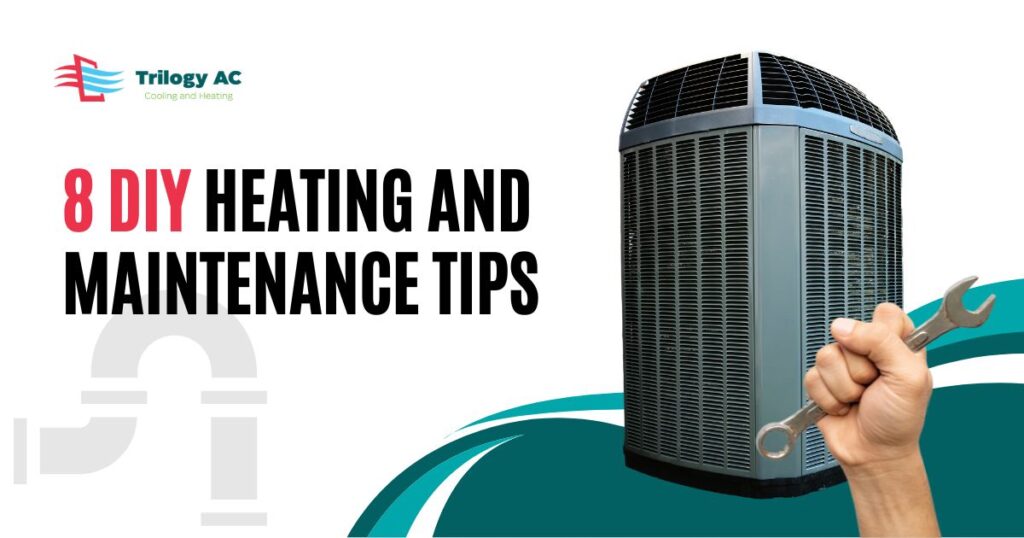Depending on the task, heating maintenance can be simple and doesn’t always require a professional. With a little TLC, your entire heating system can run more smoothly. Checking it should be on your to-do list during the fall months. This doesn’t eliminate the need for a professional tune-up each year, but it has many benefits, including the following:
- Improved comfort
- Increased energy efficiency
- Longer equipment lifespan
- Reduced wear and tear
- Fewer costly repairs
How to Maintain Your Heating System
The following DIY heating maintenance tips can keep your furnace running efficiently:
- Change the Filter as Recommended
- Check the Thermostat
- Clean the Vents in Your Home
- Clean Off the Outside Unit
- Look for Signs of Air Leakage
- Test Your Smoke and Carbon Monoxide Detectors
- Clean the Humidifier (If Your HVAC System Has One)
- Schedule a Tune-Up
1. Change the Filter as Recommended
The air filter should be inspected every month. Replace it whenever it’s dirty or clogged. Most HVAC filters must be replaced at least every three months. Oil filters must be changed annually (if you have an oil-fired furnace or boiler). Forgetting to change the filter can allow dust and other contaminants into your HVAC system, which can strain it.
When changing a filter, know the size you need. The length, width, and depth should be printed on the side of the filter. If you are not sure what you need, measure the filter slot and round to the next whole number. Replacing a filter is as simple as removing the old one from the slot (usually behind a door or access cover on the furnace) and inserting the new one so the arrows point toward the heating unit.
2. Check the Thermostat
Your thermostat can be used to perform heating maintenance and determine if your furnace is working. In the spring and fall, turn up the heat settings, wait for the furnace to kick in, and let it run for a while. If it stays on, this tells you everything is fine.
However, if the furnace stays on for only a few minutes and switches off, there’s a problem. Check that the thermostat is in “Heat” mode. If it is and the unit is short-cycling, call a professional.
You can also test fan speeds, functions, and settings when checking the thermostat. Verifying the date, time, and programmed heating schedules are correct also helps determine whether it’s working.
3. Clean the Vents in Your Home
Both internal and external vents should be clean. If internal vents get blocked with dust, dirt, pet hair, etc., airflow to your furnace can be restricted. This can strain the unit and prevent air from properly circulating throughout your home. Fortunately, these issues can be avoided by dusting off the vents in each room.
Exterior vents, including the chimney, can get blocked by debris. Vegetation, snow, and animal nests can also cause blockages that may lead to carbon monoxide leaks. While inspecting the exterior of your home, inspect the chimney and any exterior vents for clogs. It’s also a good idea to check the flue pipe, including where it connects to the furnace, for holes or gaps.
4. Clean Off the Outside Unit
Cleaning the outside unit is an important heating maintenance task, but don’t disassemble it. Check for leaves that can block the fan, especially in the fall. Leaves and debris should be removed so they don’t block airflow, which can cause the fan to malfunction. Also, foliage, equipment, and other items should be cleared away to leave at least two feet of space on all sides.
5. Look for Signs of Air Leakage
Leaky windows and doors can cause heated air to escape or cold air to enter your home. This can cause your furnace to run longer and work harder. Sealing door frames and window edges with foam strips is simple, but can lower your heating costs and protect your heating system from damage and breakdowns.
To check for air leaks, feel for drafts or hold a candle near a window or door frame. If the candle flame moves, there’s air getting through. You can seal a small gap or space yourself. Hiring an HVAC contractor to perform an energy audit can help find any efficiency issues around your home to address.
6. Test Your Smoke and Carbon Monoxide Detectors
It may not sound like heating maintenance, but checking your smoke and CO detectors is essential. These devices can alert you of potential problems with a fuel-combustion furnace. They also protect you in case of a fire or carbon monoxide leak, which can be deadly. Your detectors should be tested, and their batteries should be replaced as recommended by the manufacturer. Smoke and CO alarms should also be replaced every few years.
7. Clean the Humidifier (If Your HVAC System Has One)
If your HVAC system has a whole-house humidifier, it should be cleaned. To clean an evaporative humidifier, remove the evaporative pad. Then wipe the interior of the cabinet, flush the unit’s water supply, and use a vinegar solution to clean the drain tubes. Then you can install a new pad. This should be done annually.
To maintain a steam humidifier, shut off the unit. Once the drain cycle is complete, turn off the power and remove the overflow pan and tank to clean them with a vinegar solution. Also, remove the tank’s O-ring and clean beneath it. Check the O-ring for damage and replace it if necessary.
8. Schedule a Tune-Up
If you haven’t already done so, schedule a furnace tune-up this year. The DIY heating maintenance tips we’ve provided can go a long way in keeping your furnace healthy. However, professional service should be done annually. A technician inspects the system and safely completes other furnace maintenance steps. If necessary, they can perform minor repairs to avoid more serious and expensive problems.
Schedule Heating Maintenance with Trilogy AC
When you need heating services in Houston, Katy, and surrounding areas, the technicians at Trilogy AC can get the job done promptly and efficiently. Our team specializes in furnace maintenance but can also help with heater installation and repair. To schedule service, call (832) 864-7573 today.








